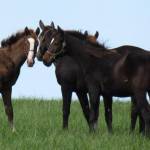Growth Comparisons Between Warmbloods and Thoroughbreds

Growth patterns of foals often leave breeders scratching their heads. Some young horses grow steadily, never going through an awkward, rump-high stage. Others seem to mature in fits and starts, failing to ever give the impression of balance. The subject of growth rates is often a point of discussion among sport horse breeders, and at times a comparison of growth patterns between warmbloods and Thoroughbreds often ensues.
Mature body size is genetically predetermined, but growth rate can be influenced by a number of factors including environment, nutrition, and management. Optimal growth rate results in a desirable body size at a specific age with the fewest developmental problems. Managing growth in horses becomes a balance between producing a desirable individual for a particular purpose without creating skeletal problems that will reduce a horse’s subsequent athletic ability.
Growing a foal too slowly could increase the risk of it being too small at a given age (if, for example, you’re speaking of a horse pointed towards a particular show at a particular age) or never obtaining maximal mature body size. Growing one too quickly, on the other hand, could result in developmental orthopedic disease such as physitis, angular limb deformities, and osteochondritis dissecans (OCD). There is no single growth rate that is desirable for all types of horses. Therefore, horses should be managed differently for varying growth rates.
For more than a decade, Kentucky Equine Research (KER) has performed extensive studies on the growth of Thoroughbred foals, recording weight and height information regularly. We compared the information gathered in these studies with the data collected from researchers that measured body weight and withers height in over 600 Hanoverian foals from birth to seven months of age.
The Hanoverian foals were slightly heavier at birth, weighing in at an average of 132 lb (60 kg) compared to 120 lb (54.5 kg). The Hanoverian foals grew slower than their Thoroughbred peers for the first three months and remained slightly smaller until five months of age. By seven months of age, however, the Hanoverian and Thoroughbred foals were nearly identical in weight and height. At this point in their growth, these Hanoverian foals weighed an average of 587 lb (267 kg) and had a withers height of 54 in (138 cm). The Thoroughbreds had an average weight of 592 lb (269 kg) and withers height of 54 in (138 cm).
In terms of percentage of mature weight and height, it is necessary to make the assumptions that an average adult Thoroughbred weighs approximately 1256 lb (570 kg) and stands 65 in (165 cm), while an average adult Hanoverian might be closer to 1430 lb (650 kg) in weight and nearly 66 in (167 cm) in height. At seven months of age, therefore, Hanoverians have attained about 41% of their adult body weight and 83% of their adult withers height. As mentioned previously, Thoroughbreds reflect similar percentages.
Much can be said about feeding growing warmbloods, so the following suggestions reflect only the most basic guidelines. At six months of age, an appropriate growth rate might be 1.75-2.0 lb/day (0.8-0.9 kg/day). Daily growth slows until the horse is gaining 0.2-0.7 lb/day (0.1-0.3 kg/day) as it enters its second year of life. Breeders should implement feeding programs that are predominantly forage-based with appropriate protein and mineral fortification to promote sound skeletal development. Fortification can come in many forms, though two popular ones might be a low-glycemic feed designed particularly for young horses or a concentrated supplement pellet that supplies the protein, vitamins and minerals needed for optimal growth. Amount fed depends largely on the individual horse and feeding directions of the chosen product.
Guidelines for feeding growing horses should be discussed thoroughly with a qualified equine nutritionist.








